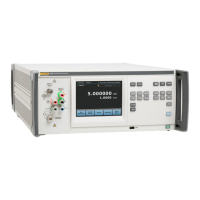5790B
Operators Manual
4-22
To eliminate dc reversal errors, average the reference against its equal and
opposite value:
1. Apply -2 V dc to INPUT 2.
2. Select the Average Reference softkey. The Product now uses the average
of the absolute values of the +2 V and - 2 V readings as the reference. This
eliminates any dc offsets.
To make ac measurements, select INPUT 1 and apply 2 V ac (at 1 kHz for
example) from the calibrator to INPUT 1. The Product shows the difference
between the 2 V, 1 kHz and the averaged dc reference as shown below. 2 V
outputs at other frequencies can be checked in a similar manner.
+/- 3% (1 year) 83 days since calibration
2/06/15 10:52am
Auto Range 22 V
V
1.0000
10.00005
kHz
Input 2
Local
hvi010.eps
The Transfer Mode can also be used to compare a known ac value to another ac
value, for example when checking the ac response (“flatness”) of an instrument.
For example, to compare the flatness of an ac calibrator at 1 V relative to its
1 kHz output.
1. Select INPUT 1 and apply 1 V, 1 kHz to INPUT 1.
2. Select the Set Reference key. The Product takes that reading as the
Reference.
Note
An average of the Reference is not necessary when making ac/ac
transfers.
3. Apply 1 V, 10 kHz to INPUT 1, and the Product shows the difference between
the present input of 1 V, 10 kHz and the reference (1 V, 1 kHz).

